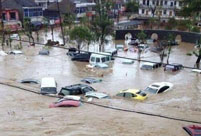WASHINGTON, Oct. 15-- For every three people killed by violence during the U.S.-led invasion and occupation of Iraq from 2003 to 2011, two died as a result of the country's collapsed health care system, water and food supply as well as transportation, an international team of researchers said Tuesday.
In all, nearly half a million people died from causes that could be associated with the war, the researchers reported in the open access journal PLOS Medicine.
The study, done by researchers from Johns Hopkins University and University of Washington in the U.S., Simon Fraser University, Canada, as well as Mustansiriya University in Iraq, is the first population-based survey research since 2006 to estimate war- related deaths in Iraq.
The researchers concluded with 95 percent certainty that there were approximately 461,000 excess deaths during the Iraqi war, but the actual number could be as low as 48,000 or as high as 751,000.
"Policymakers, governments and the public need better data on the health effects of armed conflict," said Amy Hagopian, associate professor of Global Health at the University of Washington and the lead author of this study, in a statement. " Without this information, it's impossible to assess the true human costs of war."
To conduct this study, the researchers went to 2,000 randomly selected households in Iraq in 100 clusters throughout the country to ensure the sample of households was nationally representative. They asked every household head about births and deaths since 2001, and all household adults about mortality among their siblings.
They found more than 60 percent of those deaths were directly attributable to violence while the rest were associated with indirect, but war-related, causes.
Based on household survey responses, gunshots were reported to cause 62 percent of violent deaths; car bombs, 12 percent; and other explosions, 9 percent. Cardiovascular conditions were the main cause of nonviolent death, accounting for 47 percent of nonviolent deaths over the entire study period.
They also found that deaths increased to twice as much as the expected levels at the onset of the war, plateaued briefly at the end of 2003, then rose again to a new peak in 2006. Thereafter, deaths dropped until 2008, when the number of deaths started to level off, and then rose again slightly in 2011.
The researchers said they adjusted the results to account for the migration of an estimated 2 million Iraqis out of the country during the war.
"There were two big reasons to do this study: to cover the entire period of the war and to improve on the groundwork laid by earlier studies," said Gilbert Burnham, professor and co-director of the Center for Refugee and Disaster Response at Johns Hopkins University. "By broadening the sources of information we used and by covering the full length of the conflict, this study provides a more complete picture of mortality during the Iraq war."
 2013 Colour Me Rad 5K run held in Canada
2013 Colour Me Rad 5K run held in Canada China's destroyer Qingdao sails out of Sydney Harbor
China's destroyer Qingdao sails out of Sydney Harbor Chinese tycoon aims to restore London's Crystal Palace
Chinese tycoon aims to restore London's Crystal Palace Worst flooding hits Yuyao, 70% of downtown area underwater
Worst flooding hits Yuyao, 70% of downtown area underwater Game for the brave: 'Spiders' in Yandang Mountains
Game for the brave: 'Spiders' in Yandang Mountains Hungarian wingsuit flyer confirmed dead in Zhangjiajie
Hungarian wingsuit flyer confirmed dead in Zhangjiajie Chinese screen goddesses from Beijing Film Academy
Chinese screen goddesses from Beijing Film Academy  Weekly Sports Photos
Weekly Sports Photos World's most amazing yacht on display in Guangzhou
World's most amazing yacht on display in Guangzhou Photo collection of Chinese Navy
Photo collection of Chinese Navy Photo story: Young tenants in Beijing
Photo story: Young tenants in Beijing Twins Culture Festival kicks off in Beijing
Twins Culture Festival kicks off in Beijing UNESCO world heritage site: Montale Tower
UNESCO world heritage site: Montale Tower Israeli drone crashes into Mediterranean, fragments recovered
Israeli drone crashes into Mediterranean, fragments recovered Fiber-optic wedding dress show shinning in Suzhou
Fiber-optic wedding dress show shinning in Suzhou Day|Week|Month